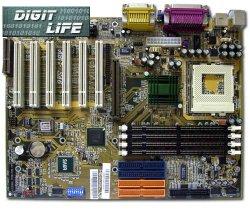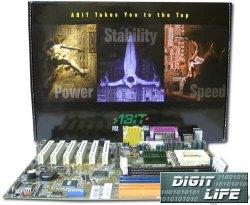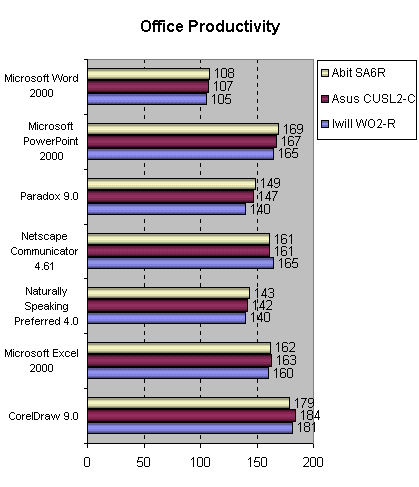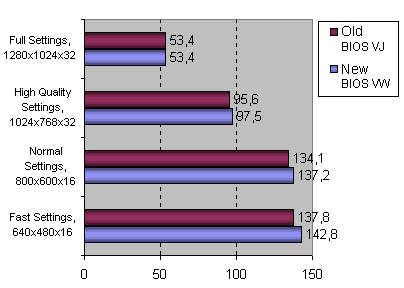 |
||
|
||
| ||
IntroductionRecollections of motherboards of this company are concerned with the first experience for many people on measurement of regular characteristics of systems – the company turned to be the first in the world when in 1996 they suggested that a user change the core voltage and FSB frequency without disassembling the computer with just a simple set SoftMenu FSB. No secret that many heard about a possibility to obtain a higher efficient computer, but when they opened a case and saw many cables and different boards, they gave up. But with new, unique possibilities of Abit’s motherboards this procedure gets so simple that any house-wife would manage to implement it. In the today’s incarnation of this technology – SoftMenu III (announced in 1999 by the company) – there were added even wider possibilities for such operations. These are: considerably increased frequency range, new values for change of the PCI frequency in relation to FSB frequency, a possibility to get help not leaving the BIOS – Item help, and many other tempting possibilities. The company takes the lead entering the new century – of course not in sale volume, but in high quality of their products and wide range of utilized innovational technologies. There are a lot of the company’s products that took the first places in many tests, but the boards possessing such a unique possibility to damage a processor are not of interest to OEM partners, so the Abit’s destiny is the end user market, and the company is developing it quite successfully. Now we are passing to the subject of our review today – ABIT SAR6 motherboard announced already a long time ago (in the computer industry 3 months is not a short time). We put our hands on a sample based on a set of i815E system logic – revision 1.0 of this board; in a new modification a new chipset Intel 815EP served a based for this board – the chipset without an integrated video adapter (which is often unnecessary and is used mainly for budget computers). The fact that the board came into our lab not immediately after release gives both advantages and disadvantages – one always want to be the first, but on the other hand with the time we receive new possibilities, higher efficiency and sustained performance thanks to new versions of BIOS. We have received a heap of questions concerning our words that new versions of BIOS greatly influence the system performance – today , with a popular game Quake 3 Arena from id Software I will show you what figures a new version of BIOS develops into. I think that to some degree it concerns all motherboards – not all would have the same results but the trend will be kept. Now I want you to look closer at the chipset possibilities – a heart of the motherboard. ChipsetThis set from Intel is based on a new Accelerated Hub Architecture and includes two chips - 82815(GMCH) and 82801BA(ICH2), and additional Firmware Hub serving a flash-memory chip. The first two hubs are connected not with a previous bus – PCI, but with a wider interface with two times higher bandwidth than of the PCI bus – 266 Mbps. It’s connected with the fact that new south bridges dispose of means for creating great loading of the bus such as ATA100, AC'97 codec etc., and consequently the previous bandwidth was not enough. Because of long-time absence of reviews on the i815Ĺ based motherboard we are to show you the specification:
WE have already considered the chipset in depth, that’s why I will directly turn to the board itself - SA6R. BoardThis board includes all “accumulations” of Abit – SoftMenuIII, ATA100 Raid controller which is becoming more and more popular solution for high efficient disc systems. The last chipset from Intel gives quite good solution for the systems based on CPUs which use Socket370. Let’s took a gander at the board specs.  Specification
The board has 4 DIMM slots what allows, according to ABIT, reach a cutoff in 512 MBytes by different ways – in fact this cutoff is rather low, and it will be enough to have three slots to reach it. On the other hand, installation of 4 128 MBytes modules makes a beautiful solution. The board is equipped with the Raid controller from HighPoint, which was considered many times in our reviews. It will help to build sufficiently efficient system on inexpensive and widespread hard discs with IDE interface. The board has a greater size than its relatives – another two centimeters adds exactly those two mentioned features. The impression from a quite convenient layout saddens us that CD-in and AUX connectors are located between the first and the second PCI slots. The DVI slot is also located inconvenient – it’s literally pressed in between AGP slot and the first PCI connector. The supply connector is brought behind the processor, and this seems to be the worst disadvantage of the board’s design. On the board there is a unit of DIP-switches which allows setting FSB frequency and a multiplier – the latter option is a clear anachronism. In order to increase system stability when exceeding the rated FSB values the developers surrounded the CPU with 17 capacitors of 1500 uF each. They were discussed in the review on the EpoX BX7+.  Studying the complete set in a box of legacy design I expected to see inside a set of programs on two CDs that is customary for Abit – a disc with Gentus Linux and a disc with utilities and various freeware. But surprisingly, there wasn’t the former disc. As to programs, you can find there a DVD player – WinDVD, a screensaver with ABIT’s logo, Xstore Pro, and a program for search on the Internet – Inforia. The complete set includes also a diskette with drivers for Raid-controller, since in case of installation of a CDD-ROM on one of the Raid-controller’s connectors, it wouldn’t be seen without the drivers. Besides, in the box you can find a cable for two more USB connectors which is to be installed on a rear panel of a computer – such cables are claimed by many manufacturers only as an option, but it takes much time to find a cable with an appropriate connector in the stores. Now, if you are using more than two USB devices you are not to do infinite shopping in search of an external USB-hub or cables for the motherboard. Besides, you will get two ATA66/100 cables, FDD cable and a bracket for the second serial port on the rear panel – its customary place is taken by a connector of an integrated video adapter. BIOS on this motherboard is based on the Award Bios v6.00PG, and its Setup offers huge possibilities for system’s configuration – there is a big choice of settings of memory configuration, and manual distribution of IRQ among PCI slots, and a new feature of power switching off when a fan stops working. The most interesting part of this BIOS is a setting of CPU parameters. Overclocking possibilitiesIn a customary SoftMenuIII we have seen nothing new – but anyway, a choice of overclocking tools is rather huge – there you can change FSB frequency from 50 to 250 MHz with 1 MHz increment just writing a required value in the dedicated table; there is a possibility to change core voltage from 1.3V to 1.9V with 0.05V increment, to change manually a ratio of FSB, SDRAM and PCI frequencies (their ratio coefficients differ depending on FSB frequency). In the following table you can find the definite values where the min SDRAM, PCI and AGP frequencies correspond to the lowest FSB frequency, and max – to the biggest one:
As you can see, the potential is royal. The only thing lacking in this board is a possibility to lift voltage on a chipset and a memory. Well, it’s high time to turn to results shown by the board in the applications. Performance
Software:
Since all the boards are based on the i815-series chipsets, we shouldn’t expect some vast break in the performance – still, let’s take a gander at how they perform.   So, the margin is very narrow – and if taking the average (add the results from all the tests and then divide by their number) the Abit SA6R would take the lead here, but the margin is less than 1 percent, and the BIOS released for any of these boards can change the situation. Anyway, it will be still within the range of 1 percent (note that this can be also taken as inaccuracy in the measurements).  Again you can see that there are no bright outsiders and bright leaders, in comparison, for example, to the results obtained two years ago.  Now I will show you the difference received with different BIOS. When we managed to put our hands on this board, the Abit’s site contained only two BIOS versions – the first one (the first edition) – with VJ index of November 1, 2000, the second one – with VW index of November 8. In the second version they corrected an error concerning determination of CPUs’ frequencies, which have the same ID, while their replacement, and they added a new BIOS for the Raid-controller. Beside all this, the results shown in the Quake3 were different – , although this is not a huge increase in speed (in case of the second BIOS version), it is still higher than the inaccuracy of measurements. So, now you can see what can be reached with a new BIOS version. ConclusionThe board turned out well, though it’s not something extraordinary in the whole series of Abit. It’s difficult to invent something new, as it was with the SoftMenu in 1996, - but the position of Abit is aimed differently. In the press-release on the Abit's site they say about extension of the market of production distribution, and this motherboard is undoubtedly lies within the frames of this strategy. The board will find its buyer, and the range of users for it is rather wide, from extreme overclocker to a system administrator pondering on what to set in a new server… The board worked stable under the control of WinNT more than 24 hours, and the last application of it doesn’t look fantastic as it was earlier – some time ago Abit faced problems of instability, mainly due to innovational technologies that needed time for adaptation. Five years passed and today Abit’s boards deserve not only home systems, but also the systems that make higher requirements to fault-tolerance. Highs
Lows
Write a comment below. No registration needed!
|
Platform · Video · Multimedia · Mobile · Other || About us & Privacy policy · Twitter · Facebook Copyright © Byrds Research & Publishing, Ltd., 1997–2011. All rights reserved. |